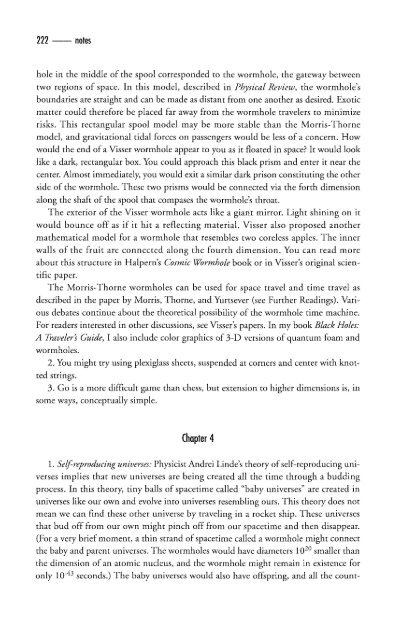clifford_a-_pickover_surfing_through_hyperspacebookfi-org
clifford_a-_pickover_surfing_through_hyperspacebookfi-org
clifford_a-_pickover_surfing_through_hyperspacebookfi-org
You also want an ePaper? Increase the reach of your titles
YUMPU automatically turns print PDFs into web optimized ePapers that Google loves.
222 notes<br />
hole in the middle of the spool corresponded to the wormhole, the gateway between<br />
two regions of space. In this model, described in Physical Review, the wormhole's<br />
boundaries are straight and can be made as distant from one another as desired. Exotic<br />
matter could therefore be placed far away from the wormhole travelers to minimize<br />
risks. This rectangular spool model may be more stable than the Morris-Thome<br />
model, and gravitational tidal forces on passengers would be less of a concern. How<br />
would the end of a Visser wormhole appear to you as it floated in space? It would look<br />
like a dark, rectangular box. You could approach this black prism and enter it near the<br />
center. Almost immediately, you would exit a similar dark prison constituting the other<br />
side of the wormhole. These two prisms would be connected via the forth dimension<br />
along the shaft of the spool that compases the wormhole's throat.<br />
The exterior of the Visser wormhole acts like a giant mirror. Light shining on it<br />
would bounce off as if it hit a reflecting material. Visser also proposed another<br />
mathematical model for a wormhole that resembles two coreless apples. The inner<br />
walls of the fruit are connected along the fourth dimension. You can read more<br />
about this structure in Halpern's Cosmic Wormhole book or in Visser's original scientific<br />
paper.<br />
The Morris-Thorne wormholes can be used for space travel and time travel as<br />
described in the paper by Morris, Thorne, and Yurtsever (see Further Readings). Various<br />
debates continue about the theoretical possibility of the wormhole time machine.<br />
For readers interested in other discussions, see Visser's papers. In my book Black Holes:<br />
A Traveler's Guide, I also include color graphics of 3-D versions of quantum foam and<br />
wormholes.<br />
2. You might try using plexiglass sheets, suspended at corners and center with knotted<br />
strings.<br />
3. Go is a more difficult game than chess, but extension to higher dimensions is, in<br />
some ways, conceptually simple.<br />
Chapter 4<br />
1. Self-reproducing universes: Physicist Andrei Linde's theory of self-reproducing universes<br />
implies that new universes are being created all the time <strong>through</strong> a budding<br />
process. In this theory, tiny balls of spacetime called "baby universes" are created in<br />
universes like our own and evolve into universes resembling ours. This theory does not<br />
mean we can find these other universe by traveling in a rocket ship. These universes<br />
that bud off from our own might pinch off from our spacetime and then disappear.<br />
(For a very brief moment, a thin strand of spacetime called a wormhole might connect<br />
the baby and parent universes. The wormholes would have diameters 10 20 smaller than<br />
the dimension of an atomic nucleus, arid the wormhole might remain in existence for<br />
only 10 3 seconds.) The baby universes would also have offspring, and all the count-







